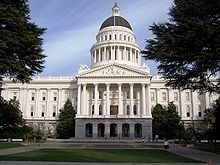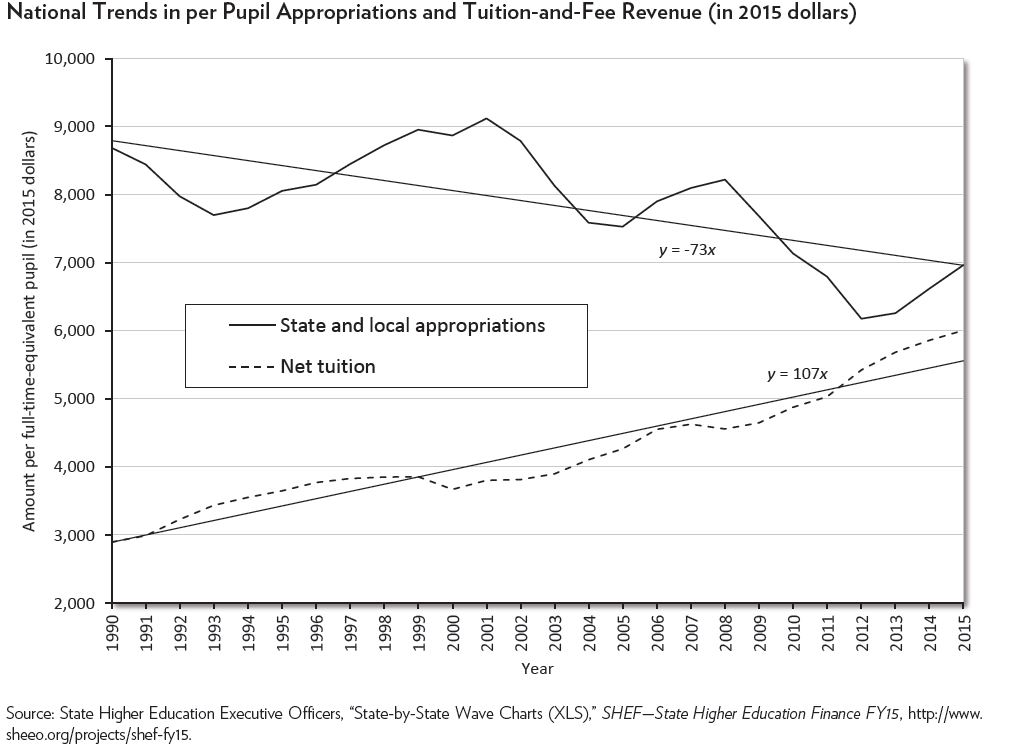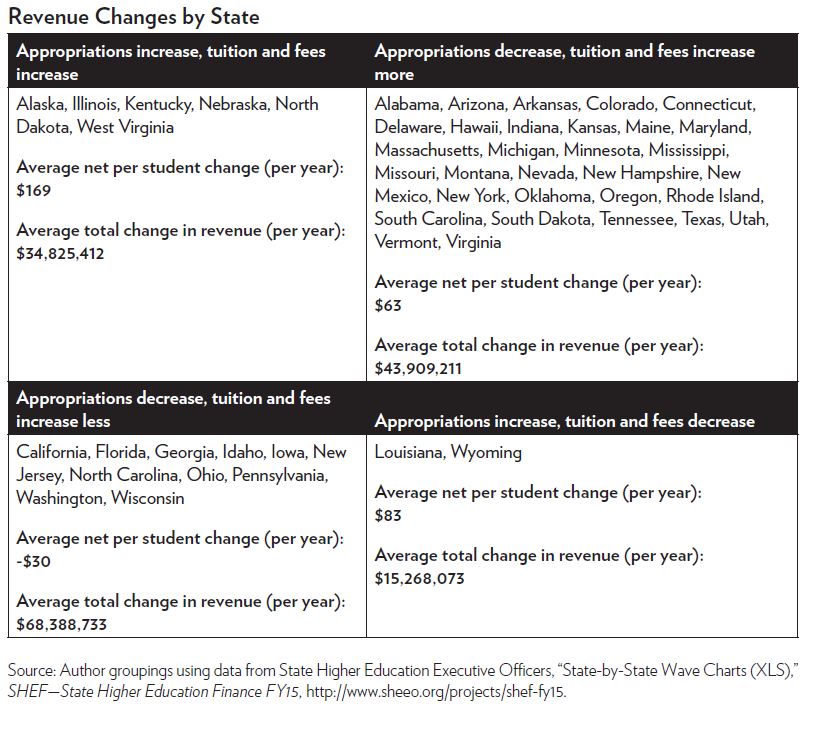
Study: Tuition increases are not entirely explained by state disinvestment
Don’t Blame State Disinvestment Alone
Tuition rose faster than state appropriations fell, and federal aid helped make that possible, study asserts. does headline overstate? should we add “(Alone)” or something, so we’re not making it seem like Cato is saying state disinvestment plays no role? dl***Good point. Added “Alone.” -RS
By Rick Seltzer
February 20, 2017
State disinvestment isn’t the whole story behind rising tuition levels.
Neal McCluskey, director of the Cato Institute’s Center for Educational Freedom, makes that argument in a new study seeking to explain increases in college and university tuition levels. It’s in some ways a middle-of-the-road finding for a libertarian think tank weighing into a debate whose different sides have long been dug in behind their favorite narratives. But it is also a distinct attempt to shift the focus at a time when some believe state funding has received too much attention in the debate over college costs and tuition levels.
Many campus leaders and higher ed analysts argue that public colleges and universities have had to raise tuition to keep their budgets balanced amid a long-term trend of decreasing state funding per student. Others reject that narrative, instead arguing that tuition hikes go to pay for increasing and often unnecessary spending — say, for posh new benefits for students, administrative bloat or inflated faculty salaries.
“I’ve heard what many times sounded to me like people saying inflation is explained by cuts in state funding,” McCluskey said in an interview. “And I just don’t think that’s an adequate explanation. I think that’s probably part of it, but it certainly doesn’t explain all of it.”
McCluskey ends his study with a more libertarian argument, though. He proceeds to suggest that colleges and universities also raise tuition because they’re always seeking more resources. If that’s the case, he reasons, federal student aid enables additional tuition increases by making more tuition money available to colleges and universities.
The availability of federal aid could then also inspire states to curtail higher education appropriations. State lawmakers know that federal aid is available and believe it will cushion students from tuition increases that stem from appropriations cuts, according to McCluskey.
That’s a more controversial argument — and it’s one McCluskey does not make in the study empirically. It does, however, stem from an evidence-based conclusion McCluskey draws about the relationship between state appropriations and tuition levels at public colleges and universities.
He starts by examining 25 years of data from the State Higher Education Executive Officers association. The data, showing public appropriations to higher education and tuition and fee revenue, is adjusted for inflation using the Higher Education Cost Adjustment. Some have criticized that adjustment, saying it is too heavily weighted toward employment costs and overstates inflation compared to the more widely known Consumer Price Index, which is more reflective of inflation students feel.
But McCluskey believes HECA is appropriate for his purposes because if it does overstate inflation, it would show a worst-case scenario for public colleges by overstating how much state funding has declined over time. His point is stronger if it can be proven even when considering that worst-case scenario.
The key parts of McCluskey’s study analyze per-student data instead of total state appropriation and tuition-and-fee levels. It’s an important distinction to draw because more students are enrolled in public higher education institutions today than were enrolled 25 years ago. Therefore, total funding levels do not demonstrate how much is actually being spent on every student. Any analyses that look at total state funding levels without taking into account the enrollment growth that most states have seen are unlikely to capture the degree of underfunding colleges say they experience.
Net tuition and fee revenue has been increasing faster than state and local appropriations have been declining, McCluskey found.
Nationwide, tuition and fee revenue rose by about $107 per full-time-equivalent student per year over the last 25 years. State and local appropriations fell by about $73 per student per year. In other words, only 68 percent of the increase in tuition and fee revenue can be explained as covering losses in state and local funding.
Conditions in individual states varied significantly, however. More than half of states, 31, experienced tuition and fee increases outpacing appropriation declines per student. Another 11 were home to tuition and fees that did not rise fast enough to offset drops in appropriations. Meanwhile, six states experienced increases in both tuition and fees and appropriations, and two states had declining tuition and fees coupled with increasing appropriations.
McCluskey also compared the average appropriation changes and tuition and fee changes at the state level — a slightly different metric than looking at the total changes of those measures across the country. He found the average state could explain only 57 percent of its increased tuition and fee revenue as covering losses in state and local funding.
“What all this strongly suggests is that yes, public institutions on a per-pupil basis have likely raised prices in part to make up for lost direct subsidies,” he wrote. “But even on a per student basis, they took in much more revenue than what was needed just to make up for lost appropriation dollars. In the aggregate, schools appear to have seen very large net revenue increases.”
The study goes on to say that other explanations likely contribute to the increase in tuition. One is William Baumol’s “cost disease” theory that higher education is labor-intensive and must pay its workers more to keep them from moving to other, better-paying industries. Another is William Bennett’s well-known “Bennett Hypothesis” that colleges will raise tuition when financial aid increases. A third explanation is that colleges and universities will take in as much revenue as possible as they seek to start new programs, build new buildings or do other work they see as valuable.
McCluskey continues by arguing that a key check on high prices is neutralized in higher education — students do not foot the entire cost of their education, so they are less likely to resist high prices. Over time, that has allowed colleges to take more money in tuition. It’s also affected the choices of state policy makers who know federal aid will make up the difference in tuition changes that come about because of state appropriation cuts, he argues. Policymakers may be more willing to cut higher ed than they are other programs or entities that have no other revenue streams besides state funding.
Mixed Reviews
Several analysts supported McCluskey’s reasoning, while others took issue with it. Representatives of the State Higher Education Executive Officers association — which gathered the data on which McCluskey’s analysis is based — took a nuanced view.
“I think there is obviously a direct relationship between per-student state funding and tuition increases, but it is certainly not the only reason that tuition goes up,” said Andy Carlson, SHEEO principal policy analyst. “It is very complicated. I’d be really cautious on anything that belittles the impact of state funding on tuition.”
Carlson, who was previously budget and financial aid director at the Colorado Department of Higher Education, has particular insight into the specific reasons institutions and educational systems raise tuition. They have to maintain certain levels of operations from year to year even though they don’t know how much money politicians will give them in the future — or exactly which students will come to campus. Students pay different amounts of net tuition depending on how much financial aid a college awards them.
Some states limit tuition increases. That can incentivize colleges to take any increase available to insulate themselves against future financial shocks.
“There might be a 3 percent limit the next year, or a 5 percent limit, but there’s talk of a downturn coming up,” Carlson said. “What’s the incentive not to raise tuition if you don’t know what the next year is going to bring?”
The SHEEO data do not allow one to make an empirical argument that federal aid enables higher tuition levels, said David Tandberg, SHEEO’s principal policy analyst. McCluskey has laid out an argument using logic, but it is an argument that is a point of debate.
“It seems like the best research argues that if it has an effect, it’s a small one,” Tandberg said. “But there are people who disagree with that.”
Some also disagree with what they see as McCluskey’s minimization of state funding levels as a driver of tuition increases.
Iris Palmer is a senior policy analyst in the Education Policy Program at New America. She pointed out that the Cato study uses two different calculations finding either 57 percent or 68 percent of annual tuition increases can be explained by drops in state and local appropriations.
“They sort of treat it as a not-high percentage,” Palmer said. “It seems to me, if state disinvestments are driving over 50 percent of public tuition increases, that’s a pretty big explanation.”
Palmer co-wrote a November paper that projected how a future recession would affect higher education finances. Only a handful of states would be able to keep per-student tuition below the current national average of about $6,000 if a recession hits within the next five years, it found.
Preston Cooper, an education data analyst at the American Enterprise Institute, said in an email that the study is a valid rebuttal to the idea that colleges are raising tuition simply to compensate for state budget cuts.
But the study also has limits, according to Cooper.
“What it does not say definitively is how much of the increase in tuition is due to budget cuts, since we don’t know the counterfactual scenario in which per-pupil appropriations remain constant,” Cooper wrote. “Arguably this is the more interesting question.”
It’s also important to emphasize that state appropriations, tuition dollars and enrollment all fluctuate in different ways depending on economic conditions, according to Art Hauptman, an independent public policy consultant specializing in higher education finance. Those conditions changed multiple times over the 25-year period.
For instance, state higher ed funding per full time equivalent dropped by 25 percent during the economic turmoil between 2008 and 2013 as enrollments increased by 15 percent. About half of the decline in state spending per student during that time frame is attributable to enrollment increases, Hauptman said.
On the other hand, tuition and fees at public institutions were flat per full-time-equivalent student in the second half of the 1990s, when state appropriations per student generally increased.
Hauptman concludes that economic conditions have a major effect on state funding for higher education. State funding falls in bad times and rises in good times, he said. But tuition rises in good and bad times alike. It just rises faster in bad times.
“The disinvestment argument is phony,” he said. “It’s a myth, and I think it’s perpetuated by folks who want the states to provide more money.”
Analysts also pointed out other limitations in the debate. The Cato study’s 25-year period starts in 1990. But there is nothing to say whether state funding for higher education was at an appropriate level then. McCluskey says his study does not make an argument about what an appropriate level of funding would be.
Nor can it be said that the optimal balance between state funding and tuition funding is the same today as it was 25 years ago. The student population has expanded and changed.
“When you have a large share of state appropriations, we find that those dollars tend to flow toward areas of student support and academic services,” said Tandberg, SHEEO’s principal policy analyst. “High tuition rates tend to restrict access. The mix, it actually does matter.”
Tandberg does not want to be seen as an apologist for higher education institutions. In many cases, colleges and universities can spend money more efficiently than they are today, he said.
Yet he also points out that broad policy analyses can obscure individual situations. In many states, flagship research universities have been able to greatly increase tuition, but smaller state institutions have not. That leaves flagships with more overall funding per student than smaller institutions, which are more reliant on state allocations and can struggle.
Over all, Tandberg would like to see a more measured discussion of tuition and state funding in the future.
“I just really, really hope it isn’t the same black-and-white debate and narrative we saw before the recession,” he said. “I hope it’s more nuanced and reflects the realities of diversity in revenue sources across institutions.”



